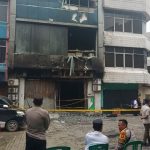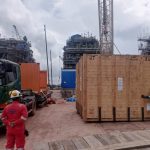Liga Asuransi – Dear risk-taker friends, how are you? I hope your business is doing well.
As a senior insurance broker, this time I want to discuss the challenges of risk management and insurance for Water Supply construction works. If you are interested in this article, please share it with your friends so they can understand as much as you do.
In Indonesia, water supply pipelines play a pivotal role in addressing multifaceted challenges related to water distribution, sanitation, and public health. The nation’s unique geography, characterized by thousands of islands, necessitates establishing efficient water distribution systems. These pipelines are indispensable for transporting water from sources to both urban and rural areas, ensuring a consistent and dependable supply.
The swift pace of urbanization and population growth in major cities amplifies the demand for a reliable water supply. Water supply pipelines become imperative in meeting the burgeoning needs of expanding urban areas, averting water shortages, and supporting sustainable development.
The significance of water supply pipelines extends to public health and sanitation. Access to clean and safe water is fundamental to reducing waterborne diseases, and pipelines contribute to a controlled and secure distribution system.
Given the prominence of agriculture in Indonesia, water supply pipelines play a crucial role in irrigation. They facilitate efficient water distribution, supporting agricultural productivity, and consequently ensuring both food security and economic stability.
The country’s susceptibility to natural disasters, including floods, earthquakes, and volcanic eruptions, underscores the importance of well-designed water supply pipelines. These pipelines contribute to disaster resilience by ensuring access to clean water even in emergencies.
Sustainable water management is integral to preserving Indonesia’s rich biodiversity and ecosystems. Water supply pipelines, when implemented with environmental considerations, contribute to responsible water resource usage.
Government initiatives underscore the acknowledgment of the importance of enhancing water infrastructure for sustainable development goals. Investments in water supply pipelines are part of broader initiatives aimed at improving overall infrastructure and living standards.
In essence, water supply pipelines in Indonesia serve as crucial conduits in overcoming geographical challenges, addressing urbanization and population growth, ensuring public health, supporting agriculture, enhancing disaster resilience, promoting environmental conservation, and contributing to government initiatives for sustainable development. Robust investment in water infrastructure is indispensable to meet the diverse and growing needs of Indonesia’s population.
UNDERSTANDING THE CONSTRUCTION OF WATER SUPPLY PIPELINES
Water supply pipeline construction weaves a crucial narrative, linking distant water sources to communities. The process begins with meticulous planning, navigating geographical nuances, and environmental impacts. Construction sites bustle with activity as crews, equipped with specialized machinery, lay the groundwork for this essential lifeline. Challenges, from weather uncertainties to geological intricacies, are met with robust risk management strategies. Environmental considerations guide route choices, harmonizing human needs with ecological preservation.
THE CRITICAL ROLE OF RISK MANAGEMENT FOR WATER SUPPLY PIPELINES
In the realm of construction projects, the critical roles of risk management and insurance are indispensable for ensuring the success and sustainability of these intricate endeavors.
Identifying and Assessing Risks:
In the initial stages, risk management involves a systematic process of identifying potential risks associated with the construction project. This includes risks related to design, construction methods, environmental factors, and regulatory compliance. Subsequently, a thorough assessment is conducted to gauge the impact and likelihood of each risk, prioritizing and focusing efforts on the most critical ones.
Proactive Planning and Mitigation:
Proactive risk management goes beyond identification and assessment. It involves the development of strategies to mitigate or minimize potential risks. This could include implementing safety protocols, utilizing advanced project management tools, or incorporating redundancy in critical systems. Contingency plans are also devised to minimize disruptions if a risk materializes.
Financial Protection and Budget Control:
A significant aspect of risk management lies in the realm of financial protection. Insurance coverage serves as a financial safety net, covering losses or damages that may occur during the construction process. This includes coverage for property damage, injuries, and other liabilities. By transferring certain risks to insurance providers, construction projects can maintain better control over their budgets, particularly crucial in large-scale projects where unexpected costs can have significant repercussions.
Legal Compliance and Liability Management:
Risk management ensures that construction projects comply with various regulations and standards, mitigating the risk of legal disputes. Insurance plays a key role in managing liabilities and protecting against legal claims arising from accidents, injuries, or property damage, thereby shielding project stakeholders from financial repercussions.
Enhancing Stakeholder Confidence:
Robust risk management and insurance practices enhance confidence among investors, stakeholders, and project participants. Knowing that potential risks are identified, assessed, and mitigated fosters trust in the project’s viability.
Project Continuity and Completion:
Unforeseen events can jeopardize project timelines. Effective risk management, coupled with insurance coverage, helps ensure project continuity by providing resources to overcome setbacks and resume construction promptly. This contributes to the timely completion of the project, minimizing delays and associated costs.
In the context of constructing pipelines for water supply, the implementation of effective risk management strategies is paramount to ensure the success, safety, and reliability of the project.
RISK MANAGEMENT STRATEGIES FOR WATER SUPPLY PIPELINES
Embarking on the construction of water supply pipelines demands a comprehensive approach to risk management, acknowledging the unique challenges associated with this critical infrastructure.
Pre-Construction Phase:
Before the ground is broken, a meticulous analysis of the construction site and feasibility studies must be undertaken. This initial phase sets the foundation for risk assessment, identifying potential environmental hazards, geological considerations, and other factors that might pose a threat to the pipeline’s integrity. The focus here is on gaining a thorough understanding of the project’s landscape and potential challenges.
Construction Phase:
As construction commences, risk management strategies shift towards the active phase of the project. Rigorous project planning and scheduling are key components, ensuring that each step is carefully coordinated to minimize delays and cost overruns. Quality control and assurance mechanisms become integral, with constant monitoring of construction processes to detect and rectify any design or engineering challenges promptly. The selection and oversight of contractors play a pivotal role, emphasizing the importance of partnering with experienced and reliable entities.
Post-Construction Phase:
Even after the pipelines are laid, risk management remains crucial. The focus shifts towards maintenance and monitoring. Regular inspections and maintenance activities are implemented to ensure the ongoing integrity and functionality of the pipelines. Additionally, having a robust emergency response and crisis management plan in place becomes vital. This includes procedures for rapid response to unexpected events, such as leaks, ensuring minimal disruption to the water supply and prompt resolution of any issues.
Throughout all phases, collaboration among stakeholders is fundamental. Engaging with local communities, regulatory bodies, and environmental agencies fosters a collaborative risk management approach. It ensures that the project aligns with environmental regulations, community needs, and safety standards.
The integration of advanced technologies also enhances risk management efforts. Data analytics and artificial intelligence can be employed for predictive risk modeling, enabling early identification of potential issues. Advanced monitoring systems provide real-time insights into the pipeline’s performance, allowing for proactive intervention and risk mitigation.
THE IMPORTANCE OF THE INSURANCE
In the complex landscape of pipeline construction, insurance plays a pivotal role in mitigating financial risks, ensuring project continuity, and providing a safety net for unforeseen events. This narrative delves into the multifaceted role of insurance in the construction of pipelines, particularly those designed for water supply.
As construction crews break ground for the installation of vital water supply pipelines, the role of insurance emerges as a critical safeguard against a spectrum of potential challenges. One of the primary types of insurance coverage in this context is Builders Risk Insurance. This coverage extends protection to the project itself, shielding it from financial losses stemming from events such as fires, theft, vandalism, or other unforeseen perils during the construction phase.
The importance of Liability Insurance cannot be overstated. Construction sites are inherently fraught with risks, ranging from accidents and injuries to property damage. Liability insurance steps in to cover legal expenses, medical costs, and potential damages, thereby shielding project stakeholders from the financial repercussions of unexpected incidents.
Environmental Insurance assumes significance in the context of pipeline construction, particularly for water supply projects. Given the sensitivity of water resources, any environmental impact resulting from construction activities can have far-reaching consequences. Environmental insurance provides coverage for cleanup costs and potential legal liabilities arising from environmental damages, ensuring that the project adheres to environmental standards and regulations.
The role of insurance extends beyond financial protection; it contributes to effective risk management. By transferring certain risks to insurance providers, construction projects maintain better control over their budgets. This is especially crucial in large-scale endeavors, where unexpected costs can have significant ramifications.
Case studies serve as illustrative examples of the transformative impact of insurance in pipeline construction. Instances where insurance coverage successfully mitigated financial losses due to unexpected events underscore the strategic foresight in securing comprehensive insurance packages.
Moreover, lessons learned from past failures in risk management without adequate insurance emphasize the importance of foresight and preparedness. Insurance serves as a proactive measure, ensuring that the project is resilient in the face of challenges, whether they be delays, accidents, or environmental contingencies.
TYPES OF INSURANCE RELEVANT TO WATER PIPELINES CONSTRUCTION
In the intricate landscape of pipeline construction, especially for water supply projects, various types of insurance coverage are deployed to safeguard against potential risks and ensure the successful and resilient completion of these vital infrastructures. Let’s delve into the specific types of insurance coverage crucial in the context of pipelines for water supply:
CAR/EAR Insurance is a foundational coverage in pipeline construction. It protects the project itself during the construction phase. This type of insurance extends coverage to potential damages or losses caused by events such as fires, theft, vandalism, and other unforeseen perils. Essentially, Builders Risk Insurance serves as a financial safety net for the project against a spectrum of risks encountered during the construction process.
Liability Insurance is paramount in the inherently risky environment of construction sites. Accidents, injuries, and property damage are potential liabilities that can arise. Liability Insurance steps in to cover legal expenses, medical costs, and potential damages, offering protection to project stakeholders against the financial repercussions of unexpected incidents. This type of coverage is essential in maintaining a safe working environment and addressing legal obligations.
- Environmental Insurance:
Given the environmental sensitivity of water supply projects, Environmental Insurance becomes crucial. This coverage is designed to address potential environmental impacts arising from construction activities. It provides financial protection for cleanup costs and legal liabilities associated with environmental damages. Environmental Insurance ensures compliance with environmental regulations and standards, mitigating the potential risks and liabilities related to environmental impact.
- Business Interruption Insurance:
Business Interruption Insurance is designed to mitigate financial losses incurred due to unexpected disruptions in the construction process. Whether caused by natural disasters, equipment failures, or other unforeseen events, this coverage helps compensate for the loss of income and additional expenses incurred during the interruption. For water supply pipeline projects, where consistent progress is critical, Business Interruption Insurance becomes a key component in ensuring project continuity.
- Professional Liability Insurance:
Professional Liability Insurance, also known as Errors and Omissions Insurance, is crucial for addressing risks related to design and engineering aspects of pipeline construction. It protects in case of design flaws, errors, or omissions that may lead to financial losses or legal claims. This coverage is particularly relevant in ensuring the quality and integrity of the pipeline design.
While not strictly insurance, surety bonds are worth mentioning. They serve as financial guarantees that the contractor will fulfill their contractual obligations. Performance bonds ensure that the project is completed according to the terms of the contract, while payment bonds guarantee that subcontractors and suppliers are paid for their work.
In essence, these types of insurance coverage collectively form a comprehensive risk management strategy for pipelines in water supply projects. They provide financial protection, ensure compliance with regulations, and contribute to the overall resilience and success of pipeline construction endeavors. Each type of coverage addresses specific aspects of risk, collectively creating a safety net that allows stakeholders to navigate potential challenges with confidence.
THE IMPORTANT ROLE OF AN INSURANCE BROKER
Insurance brokers play a crucial role in the procurement and management of insurance coverage for pipelines in water supply projects. Their expertise and services are invaluable in navigating the complex landscape of insurance, ensuring that project stakeholders secure appropriate coverage tailored to their specific needs. Here’s an exploration of the crucial role of insurance brokers in this context:
Risk Assessment and Analysis:
Insurance brokers conduct thorough risk assessments and analyses specific to pipeline construction for water supply projects. They identify potential risks associated with the construction process, environmental factors, regulatory compliance, and other project-specific considerations.
By understanding the unique risks involved, insurance brokers can recommend tailored coverage options that address the specific challenges inherent in water supply pipeline projects.
Customized Coverage Solutions:
Based on the identified risks, insurance brokers work with a network of insurance providers to tailor coverage solutions that meet the project’s unique requirements. This includes ensuring coverage for potential environmental liabilities, construction-related risks, and other specific concerns relevant to pipeline construction.
Customized coverage solutions provide a comprehensive safety net, addressing both common risks in construction projects and those unique to water supply pipelines.
Market Access and Negotiation:
Insurance brokers have access to a wide range of insurance markets and providers. This access allows them to negotiate favorable terms, conditions, and pricing on behalf of their clients. This is particularly crucial for securing cost-effective coverage that aligns with the project budget.
The ability to navigate the insurance marketplace ensures that project stakeholders receive competitive quotes and optimal coverage terms.
Claims Assistance and Advocacy:
In the event of a claim, insurance brokers serve as advocates for their clients. They facilitate the claims process, ensuring a smooth and timely resolution. This includes liaising with insurance providers, managing documentation, and representing the client’s interests throughout the claims settlement process.
Claims assistance provided by insurance brokers is instrumental in minimizing disruptions to the project and maximizing the benefits of insurance coverage.
Risk Management Consultation:
Insurance brokers offer ongoing risk management consultation throughout the project lifecycle. This involves providing guidance on strategies to mitigate risks, improve safety protocols, and enhance overall project resilience.
Proactive risk management consultation helps project stakeholders implement measures to prevent potential issues, ultimately reducing the likelihood of claims and ensuring a smoother construction process.
Policy Review and Renewal:
Insurance brokers regularly review insurance policies to ensure that they remain aligned with the evolving needs of the project. They assess changes in risk profiles, regulatory environments, and project scopes, recommending adjustments to coverage as necessary.
During policy renewals, brokers reassess market conditions, negotiate terms, and explore opportunities for optimizing coverage based on the project’s current status and future projections.
In summary, insurance brokers play a pivotal role in the insurance coverage for pipelines in water supply projects. Their expertise in risk assessment, negotiation, claims advocacy and ongoing consultation contributes to the overall success and resilience of the construction endeavor. By partnering with insurance brokers, project stakeholders can navigate the complexities of insurance, secure appropriate coverage, and effectively manage risks throughout the entire lifecycle of the project.
CONCLUSION
In conclusion, the successful execution of pipeline construction projects for water supply hinges on a robust interplay between risk management strategies and comprehensive insurance coverage. The narrative unfolds with an acknowledgment of the diverse risk exposures inherent in such ventures, ranging from environmental hazards to project-specific challenges and regulatory complexities. The role of risk management emerges as a proactive force, guiding stakeholders through meticulous planning, strategic mitigation efforts, and a commitment to environmental and safety standards.
Furthermore, the narrative underscores the critical role of insurance in fortifying these construction projects against unforeseen circumstances. Builders Risk Insurance stands as a bulwark during the construction phase, shielding the project from various perils. Liability Insurance assumes significance, offering financial protection and legal coverage in the dynamic and inherently risky construction environment. Environmental Insurance becomes a crucial facet, aligning the project with environmental regulations and safeguarding against potential ecological impacts.
The narrative also emphasizes the importance of insurance brokers in orchestrating this intricate dance between risk management and insurance coverage. These professionals, armed with expertise and market insights, navigate the complexities of insurance procurement, ensuring tailored coverage solutions, competitive pricing, and effective claims management. Their role extends beyond transactional aspects; insurance brokers serve as trusted partners, offering ongoing risk management consultation and advocating for the client’s interests throughout the project’s lifecycle.
In essence, the synergy between risk management strategies and insurance coverage for water supply pipeline construction is pivotal. It provides not only a financial safety net but also a framework for proactive planning, regulatory compliance, and stakeholder confidence. Through this comprehensive approach, pipeline projects can navigate challenges with resilience, ensuring the reliable and timely delivery of essential water resources to communities. As we navigate the future of infrastructure development, the integration of these elements remains foundational, underscoring the symbiotic relationship between effective risk management, insurance protection, and the success of construction projects.
One of the leading insurance brokers focusing on the construction of pipeline and water system in Indonesia is L&G Insurance Broker.
For all your insurance needs in Indonesian please call L&G now!
—
LOOKING FOR INSURANCE PRODUCTS? DON’T WASTE YOUR TIME AND CONTACT US RIGHT NOW
L&G HOTLINE 24 HOURS: 0811-8507-773 (CALL – WHATSAPP – SMS)
website: lngrisk.co.id
E-mail: customer.support@lngrisk.co.id
—








![[RECAP WEBINAR: Heavy Eqipment, Heavy Risk]
Dalam industri konstruksi dan pertambangan, alat berat bekerja di lingkungan penuh risiko. Mulai dari perpindahan antar lokasi, operasi di medan ekstrem, hingga potensi kecelakaan dan kerusakan mekanis. Tanpa perlindungan yang tepat, kerugian yang muncul bisa mencapai ratusan juta hingga miliaran rupiah.
Webinar ini membahas secara mendalam:
✅ Risiko utama yang mengancam alat berat di proyek konstruksi & tambang
✅ Jenis perlindungan penting seperti CPM (Contractor’s Plant & Machinery) dan Equipment All Risks
✅ Klausul yang sering terlewat oleh pemilik alat dan perusahaan rental
✅ Peran krusial broker asuransi dalam memastikan penutupan polis tepat dan klaim berjalan mulus
Dengan jaminan asuransi alat berat yang sesuai, operasional proyek Anda tetap aman, efisien, dan terlindungi dari kerugian besar.
📣 Nantikan webinar edukatif berikutnya dari L&G Insurance Broker untuk memperluas wawasan Anda tentang manajemen risiko di industri konstruksi dan alat berat! Follow akun kami dan aktifkan notifikasi agar tidak ketinggalan😉
#webinargratis #onlinewebinar #webinar #AsuransiAlatBerat #HeavyEquipment #CPMInsurance #MiningSafety #BrokerAsuransi #AmanBersamaLNG](https://scontent-yyz1-1.cdninstagram.com/v/t51.82787-15/583486524_18408253015184229_1382819462085136671_n.jpg?stp=dst-jpg_e35_tt6&_nc_cat=105&ccb=7-5&_nc_sid=18de74&efg=eyJlZmdfdGFnIjoiQ0FST1VTRUxfSVRFTS5iZXN0X2ltYWdlX3VybGdlbi5DMyJ9&_nc_ohc=LEFLS1E6-n4Q7kNvwGkDmyY&_nc_oc=AdnNy0zp0yC2tU0WPBFouFKVjuKRuwBFqR0UNGy6wHFxS6WpLLLJGtM4B1Fzr8Mrd17mFA0DjZunYhLtsFuHsij8&_nc_zt=23&_nc_ht=scontent-yyz1-1.cdninstagram.com&edm=ANo9K5cEAAAA&_nc_gid=oSeaLBWaR-XQBec5hvxCrg&oh=00_Afkx-0gMbHtcHjqh0tCatfkjYDi6lnE953VfIoObFA0qhQ&oe=69458CEF)
![[HADIRI WEBINAR GRATIS]
L&G Academy Online Webinar: Heavy Equipment, Heavy Risk! Wajibnya Perlindungan Asuransi Alat Berat bagi Kontraktor dan Pemilik Alat
Dalam proyek konstruksi dan pertambangan, alat berat adalah aset bernilai tinggi yang menjadi tulang punggung operasional. Namun, kerusakan, kecelakaan, atau kehilangan alat di lapangan bisa menimbulkan kerugian besar dan menghentikan pekerjaan di tengah jalan.
Banyak kontraktor dan pemilik alat baru sadar pentingnya asuransi setelah kerugian terjadi. Padahal, perlindungan yang tepat bisa menjadi penyelamat bisnis.
🎙️ Narasumber:
Mhd. Taufik Arifin
CEO & Founder L&G Insurance Brokers
Lebih dari 40 tahun pengalaman menangani asuransi alat berat, marine, dan proyek besar di Indonesia
📅 Rabu, 12 November 2025
🕙 10.00 WIB – selesai
📍 Live via Zoom
💰 GRATIS! Kuota terbatas
🔗 Registrasi di: bit.ly/3JuYYfh
📲 Daftar sekarang sebelum Anda menyesal jadi salah satu yang “baru sadar setelah rugi besar.”
📞 0811-8507-773
#webinargratis #webinaralatberat #onlinewebinar #kelaswebinargratis #mining #miningequipment #heavyequipment #alatberat #heavyequipmentinsurance #CPM](https://scontent-yyz1-1.cdninstagram.com/v/t51.82787-15/572482319_18404442202184229_2761295381299065355_n.jpg?stp=dst-jpg_e35_tt6&_nc_cat=110&ccb=7-5&_nc_sid=18de74&efg=eyJlZmdfdGFnIjoiRkVFRC5iZXN0X2ltYWdlX3VybGdlbi5DMyJ9&_nc_ohc=YBfuRTABJ5wQ7kNvwEW7q4b&_nc_oc=Adkvywr5WKX6XNcVupQZSVipyaZqfSkpP0dNa7mntKR8bncwCn3olM6crU_KE5LbWJpJpmFdBkCbEoW954Tt7cVM&_nc_zt=23&_nc_ht=scontent-yyz1-1.cdninstagram.com&edm=ANo9K5cEAAAA&_nc_gid=oSeaLBWaR-XQBec5hvxCrg&oh=00_AfmiY4iIbjZ5sEt0hfrf_22YP5cfD6B2RXuaavJfW9Hw9g&oe=694586FF)

![[RECAP WEBINAR: Strategi Asuransi yang Tepat untuk Melindungi Risiko Proyek PLTS]
Proyek PLTS, baik Rooftop maupun Floating Solar Farm, menyimpan risiko unik mulai dari gangguan instalasi, cuaca ekstrem, hingga keterlambatan operasional yang bisa menimbulkan kerugian besar.
Webinar kami membahas strategi asuransi yang tepat untuk melindungi proyek Anda dari risiko-risiko ini, termasuk:
✅ Jenis risiko yang harus diperhatikan
✅ Pilihan proteksi dari tahap konstruksi hingga operasional
✅ Peran broker asuransi untuk memastikan polis sesuai karakteristik proyek
Dengan proteksi yang tepat, proyek PLTS dapat berjalan lancar, aman, dan memberikan hasil optimal tanpa khawatir risiko tak terduga.
📣 Jangan lewatkan webinar kami berikutnya dengan topik yang lebih menarik dan penuh insight praktis!
Follow akun kami dan aktifkan notifikasi agar selalu update.
#PLTS #RenewableEnergy #AsuransiProyek #BrokerAsuransi #FloatingSolar #SolarEnergy #RiskManagement #AmanBersamaLnG #GreenEnergy](https://scontent-yyz1-1.cdninstagram.com/v/t51.82787-15/565040657_18401624725184229_5747722940848587674_n.jpg?stp=dst-jpg_e35_tt6&_nc_cat=106&ccb=7-5&_nc_sid=18de74&efg=eyJlZmdfdGFnIjoiQ0FST1VTRUxfSVRFTS5iZXN0X2ltYWdlX3VybGdlbi5DMyJ9&_nc_ohc=e0noSuZP2ykQ7kNvwGYyHVN&_nc_oc=AdkGAAOFx4X9n5E8PNKtMMXUydSIodGVkfqyHYPuiU0Ub_tTVi3xnstncVYWO2HB8SjIchCZ-gajjxDHAstvTvcm&_nc_zt=23&_nc_ht=scontent-yyz1-1.cdninstagram.com&edm=ANo9K5cEAAAA&_nc_gid=oSeaLBWaR-XQBec5hvxCrg&oh=00_AfkjSayHcdH_uRNf3ydYnj5GGr-c-q9zwzde6xA8rhJeeA&oe=69457E41)










